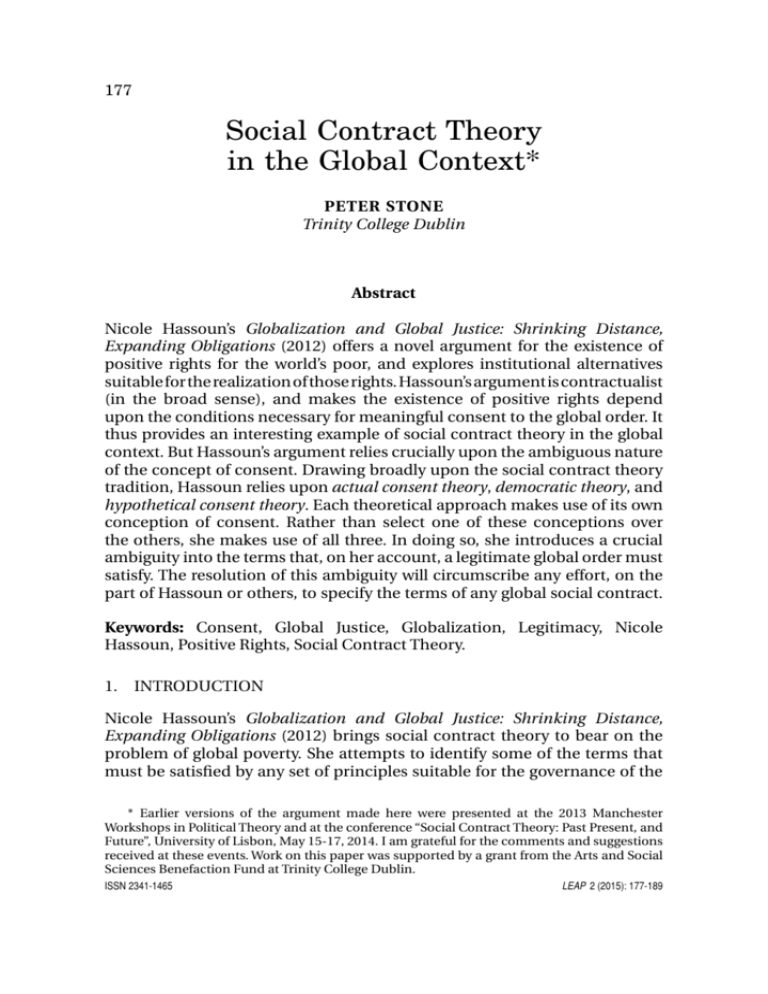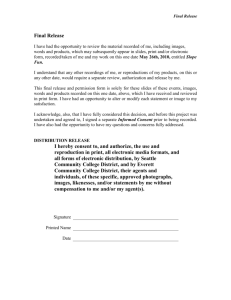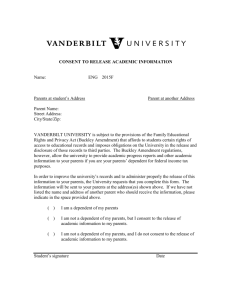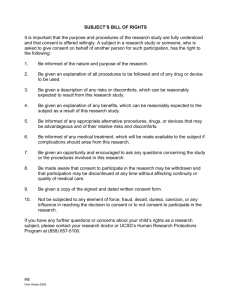Social Contract Theory in the Global Context
advertisement

177 Social Contract Theory in the Global Context* Peter Stone Trinity College Dublin Abstract Nicole Hassoun’s Globalization and Global Justice: Shrinking Distance, Expanding Obligations (2012) offers a novel argument for the existence of positive rights for the world’s poor, and explores institutional alternatives suitable for the realization of those rights. Hassoun’s argument is contractualist (in the broad sense), and makes the existence of positive rights depend upon the conditions necessary for meaningful consent to the global order. It thus provides an interesting example of social contract theory in the global context. But Hassoun’s argument relies crucially upon the ambiguous nature of the concept of consent. Drawing broadly upon the social contract theory tradition, Hassoun relies upon actual consent theory, democratic theory, and hypothetical consent theory. Each theoretical approach makes use of its own conception of consent. Rather than select one of these conceptions over the others, she makes use of all three. In doing so, she introduces a crucial ambiguity into the terms that, on her account, a legitimate global order must satisfy. The resolution of this ambiguity will circumscribe any effort, on the part of Hassoun or others, to specify the terms of any global social contract. Keywords: Consent, Global Justice, Globalization, Legitimacy, Nicole Hassoun, Positive Rights, Social Contract Theory. 1. INTRODUCTION Nicole Hassoun’s Globalization and Global Justice: Shrinking Distance, Expanding Obligations (2012) brings social contract theory to bear on the problem of global poverty. She attempts to identify some of the terms that must be satisfied by any set of principles suitable for the governance of the * Earlier versions of the argument made here were presented at the 2013 Manchester Workshops in Political Theory and at the conference “Social Contract Theory: Past Present, and Future”, University of Lisbon, May 15-17, 2014. I am grateful for the comments and suggestions received at these events. Work on this paper was supported by a grant from the Arts and Social Sciences Benefaction Fund at Trinity College Dublin. ISSN 2341-1465 LEAP 2 (2015): 177-189 178 Peter Stone global arena —by any global social contract, if you will. Among these terms Hassoun focuses upon a number of obligations the world order incurs towards the world’s poor. Or, putting things the other way around, her focus is upon the rights that a global social contract must guarantee the poor. Given the persistence and severity of global poverty, the importance of her project is hard to overstate. In bringing the idea of a social contract to bear in the global arena, Hassoun is in very good company. Some of the most important work on global justice over the past fifty years has made similar use of social contract theory (e.g., Beitz 1999, Rawls 1999a). But social contract theory carries with it a large amount of philosophical baggage. This baggage includes persistent philosophical problems that have proven very difficult to solve. In this short paper, I wish to focus upon one of these problems —the problem of consent. The concept of consent is critical to social contract theory; it does little good to speak of a contract if one cannot also speak of people consenting to that contract in some way. But there are various ways of speaking about consent in the social contract tradition. The concept of consent has, within that tradition, given rise to various conceptions of consent. 1 Any effort to defend some vision of the social contract must specify a sense in which people can be said to consent to this vision, or else risk introducing a critical ambiguity. Such ambiguity, I shall argue, bedevils Hassoun’s efforts to defend the terms she wishes to attach to a global social contract. 2. CONSENT IN THE GLOBAL CONTEXT Globalization and Global Justice offers a novel argument for the existence of positive rights for the world’s poor. 2 Hassoun dubs this argument the Autonomy Argument 3, and it proceeds as follows: (1) Coercive institutions must be legitimate. (2)For a coercive institution to be legitimate it must ensure that its subjects secure sufficient autonomy to autonomously consent to, or dissent from, its rules (henceforth, sufficient autonomy). (3)Everyone, to secure this autonomy, must secure some food and water, and most require some shelter, education, health care, social support, and emotional goods. (4)There are many coercive international institutions. (C)So, these institutions must ensure that their subjects secure food, water, and whatever else they need for sufficient autonomy 1. On the concept/conception distinction, see Rawls (1999b, 5). 2. I examine the specifics of Hassoun’s argument in more detail in Stone (Forthcoming-b). 3. Hassoun refers to this argument, with minor differences in wording, as the legitimacy argument elsewhere in the book (92). LEAP 2 (2014) 179 Peter Stone (Hassoun’s emphasis; Hassoun 2012: 45; all further references will be to this book unless otherwise indicated). Essentially, Hassoun’s argument is contractualist in nature. 4 Coercive political institutions, whether domestic or global, require consent for legitimacy. But consent requires autonomy, and the subjects of these institutions cannot grant this consent if they lack the autonomy necessary for doing so. Coercive institutions must therefore ensure that their subjects have this autonomy, or else stop coercing them. Few non-anarchists would suggest dismantling the world’s coercive institutions completely, whether they be national or global, and so those institutions must meet substantive obligations to the world’s poor in order to ensure them the autonomy necessary for consent. Those poor, in turn, enjoy corresponding positive rights. In a world where the poorest of the poor suffer from terrible absolute levels of deprivation —malnutrition that may be sufficient to produce cognitive impairment, for example— these rights are likely to be substantial, and impose meaningful burdens upon the global order. Hassoun hopes that her argument will prove convincing to many readers who might otherwise be skeptical of the existence of positive rights. She frames her argument to appeal to libertarians in particular, and devotes an entire chapter specifically to them (ch. 3). In this chapter, she usefully develops the tension between the libertarian ideas of consensualism (people can consent to anything) and minimalism (only a minimal, nightwatchman state can be a legitimate state). If an individual can consent to slavery, why can’t an entire society consent to a Soviet-style command economy (97)? Following A. John Simmons (2005), Hassoun believes that the tension should be resolved in favor of consensualism. But if consent really belongs at the heart of libertarian political theory, then libertarians have good reason to accept some version of the Autonomy Argument. Hassoun’s Autonomy Argument, then, moves from legitimacy to consent, from consent to autonomy, and finally from legitimacy to autonomy. Legitimacy (on the part of coercive institutions) requires consent. Consent requires autonomy; those lacking autonomy cannot consent. And therefore legitimacy requires autonomy —specifically, it requires a coercive institution to ensure autonomy on the part of its subjects. It is the first move of the argument —the move from legitimacy to consent— that is especially critical. If this move is carried out successfully —if it can be established that legitimacy requires consent— then the conditions required for that consent (especially the conditions of autonomy upon which Hassoun focuses her 4. I am using the term “contractualist” in the broad sense, and not the narrow sense given to it by Thomas Scanlon (1998). In this broad sense, the term refers to “the view that morality is based on contract or agreement” (Ashford and Mulgan 2012). LEAP 2 (2014) 180 Peter Stone attention) should follow straightforwardly. This first move, therefore, must be made with particular care. Does legitimacy require consent? Answering this question requires both a conception of legitimacy and a conception of consent. On the understanding of legitimacy endorsed by Hassoun, “a coercive institution is legitimate if, and only if, the institution has the justification-right to use coercive force”. “An institution”, Hassoun further explains, “has a justification-right to make coercive rules and give coercive commands if it is morally permissible for it to do so” (47, emphasis in original). This justification-right is a “liberty right”, or what Hohfeld would call a privilege (Hohfeld 2010: 38-50). It is permissible for a legitimate coercive institution to use coercive force ­—that is, nobody has a right to demand that it cease doing so— but nobody need have an obligation either to obey the institution or to help it enforce its will. Obviously, this is a very limited understanding of legitimacy, one that Hassoun distinguishes from justified authority. A coercive institution has the latter if and only if “individuals have a moral duty to comply with its rules” (49). This is probably closer to what many people envision by legitimacy, but Hassoun’s weaker definition of the term is all she needs for her project. Hassoun’s understanding of legitimacy, while not uncontroversial, is quite clear and consistent. Her understanding of consent, however, is quite different. This understanding, I shall argue, is profoundly ambiguous in precisely the ways characteristic of the social contract theory tradition. Hassoun addresses her argument to liberals, but only liberals of a contractualist bent. 5 She is not completely consistent here. On the one hand, she admits that her arguments “will not appeal to everyone who is concerned with freedom”. On the other hand, she claims that she is addressing “those who believe everyone should have some basic freedoms” (12, emphasis in original). On the one hand, her argument “is intended to appeal to everyone who takes a particularly liberal commitment to freedom seriously” (43). On the other hand, she explicitly contrasts liberalism with consequentialism, including utilitarianism (8). She seems to regard consequentialism and totalitarianism as equally alien to liberalism. (Indeed, totalitarianism and consequentialism are the only rivals to liberalism explicitly mentioned by her). Either Hassoun denies that John Stuart Mill took “a particularly liberal commitment to freedom seriously”, or else her argument is really intended to appeal only to a particular form of liberal —essentially, a liberal who emphasizes consent as the foundation for political legitimacy. At times, Hassoun acknowledges that the consent-driven approach she considers is not all there is to liberalism. “Not all liberals” she admits, “will agree that respect for persons, autonomous or not, requires refraining from 5. I discuss further Hassoun’s understanding of liberalism in Stone (Forthcoming a). LEAP 2 (2014) 181 Peter Stone forcing them to do things to which they cannot even object. Still, there is one important strand of liberal thought that supports this contention” (68, emphasis in original). But at the same time, she seems very reluctant to acknowledge any theory that does not put consent at its heart as liberal, or even sane. “What would accounts of legitimacy look like that denied that subjects must have basic freedoms under coercive institutions? On such accounts, coercive institutions could be legitimate even though people living under these institutions could not even freely object to them. It is hard to see how such institutions would not be totalitarian” (63, emphasis in original). Perhaps the line between consequentialism (à la John Stuart Mill) and totalitarianism is not (in Hassoun’s eyes, at least) all that thick after all. Still, the most charitable way to read Hassoun’s argument (a few inconsistencies notwithstanding) is as an appeal to the contractualist approach to liberal thought, to the exclusion of non-contractualist approaches. 6 Hassoun thus puts social contract theory, with its emphasis upon consent, at the heart of liberal theory (even though not all liberals are contractualists). In doing so, she acknowledges the profoundly ambiguous nature of the concept of consent that lies at the heart of social contract theory. Her acknowledgement of this point is worth quoting at some length: At the heart of liberalism is concern for individual freedom. [A] powerful strand in liberal thought... expresses the idea that the actual relationship between the rulers and each person who is ruled must be voluntary in some way. Still, those who are concerned about individual freedom disagree about what makes this relationship voluntary. On liberal communitarian theories, for instance, this relationship is voluntary if the rulers allow or support communities of appropriate kinds that need not be explicitly consensual. Other liberal theories make consent central to legitimacy. On hypothetical consent theories, for instance, the relationship between rulers and ruled is only voluntary if (reasonable) people would agree to be subject to the rulers’ dictates were they asked. Democratic theory requires more. On democratic theory, legitimacy arises through the democratic process where the majority must actually consent to the institutions to which they are subject. Perhaps the most demanding theory of this type is actual consent theory. On actual consent theory, coercive institutions are legitimate only if they secure their subjects’ actual consent (57-58, emphasis in original). Hassoun seems to believe that many (though not all) liberals want political relationships to be voluntary. Some of these liberals are social contract theorists, 6. I am equating here contractualist approaches with consent-based approaches. This is not an uncontroversial move, but space prohibits any defense of it here. LEAP 2 (2014) 182 Peter Stone who may be actual consent theorists, democratic theorists, or hypothetical consent theorists. There are liberals, however, who are not social contract theorists and still want voluntariness to be part of political relationships. Among these are liberal communitarians. Hassoun never explains how this emphasis upon voluntariness works outside of the social contract theory tradition. Moreover, she devotes little time to liberal communitarianism (5960), and so I take contract theory to be the focus of her attention. Hassoun thus identifies three forms of social contract theory —actual consent theory, democratic theory, and hypothetical consent theory. Each holds that political legitimacy depends upon some form of consent. They disagree regarding just what constitutes the appropriate form of consent. Rather than select one of these three forms of theory, Hassoun intends her argument to apply to them all. But as a result of this, whenever she invokes the idea that legitimacy depends upon consent —an idea upon which her Autonomy Argument depends— her account becomes ambiguous between three very different conceptions of consent. Take actual consent theory, for example. At times, Hassoun avails herself of the conception of consent usually employed in settings unrelated to political theory. This is the conception upon which actual consent theory relies. On this conception, to consent means “to permit, approve, or agree; comply or yield”. 7 In the political context, a person consents to an institution when she indicates (through whatever means are appropriate) her agreement to conform to its dictates. The idea is that coercive institutions are only legitimate if their subjects agree to accept them. Hassoun appeals to this conception of consent on many occasions. She explicitly acknowledges “an idea implicit in the social contract tradition — focusing upon what social arrangements people could freely accept” (47). For people, according to Hassoun, to consent to coercive institutions is for them “to autonomously agree to their rules” (9). People must “agree to be subject to coercive institutions” (10). Moreover, Hassoun’s understanding of why legitimacy requires consent fits well with this understanding of consent. Coercive institutions require consent in order to be legitimate “because their subjects have a natural right to freedom” (18). 8 People have a right to be free, in other words, unless and until they agree otherwise. This agreement can take place at a high level. Hassoun writes: 7. http://dictionary.reference.com/browse/consent?s=t, last accessed October 28, 2014. 8. Hassoun follows Hart (1955) here. Technically, she argues that “as long as one does not violate another’s rights, justification is necessary to abridge one’s natural right to freedom” (52; see also 49). As stated, this isn’t a very demanding condition; it just means you need to have a good reason to coerce someone, which presumably even fascists think they have. But Hassoun clearly means that because of the natural right to freedom, justification for coercion is owed to the people coerced, and must satisfy them. And this is effectively actual consent theory. LEAP 2 (2014) 183 Peter Stone Subjects may need to be able to process some information for autonomy, but they do not have to be able to agree to every single coercive rule to which they are subject. Subjects may only need to be able to autonomously agree to the general principles underlying their coercive institutions. Alternately, consent may require only that individuals autonomously agree to the general structure of coercive rules to which they are subject, not every subsidiary rule (29). The point remains, however, that without explicit consent to coercive institutions (at some level), these institutions cannot legitimately act. This understanding of consent has been present since the beginnings of social contract theory . But its limitations have been understood for almost as long . For anyone adhering to this conception of consent must either admit that no state has ever been legitimate, or else stretch the conception to its breaking point. No state, or coercive institution resembling a state, has ever obtained agreement to be bound by its rules from every one of its subjects, most have obtained such agreement from at best a handful of those subject to its rules (immigrants, perhaps), and many states have never obtained such agreement from any of their subjects. Moreover, it is hard to see how the ideal of actual consent could even be approached in the real world; in a society with even the most minimal level of diversity, it is impossible to imagine any political arrangement that all its potential subjects would be willing to authorize. Moreover, the costs of seeking actual consent on a wide scale (identifying possible terms, running those terms by citizens, adjusting those terms in light of the number unwilling to consent, etc.) are clearly prohibitive. Contract negotiations are difficult enough with two parties, let alone millions. 9 This point poses a problem for actual consent theory, except for philosophical anarchists willing to accept the illegitimacy of all realistic political arrangements (e.g., Wolff 1998). This problem pushes consent theory towards counting as “consent” actions or omissions that would not count as consent in other contexts. This approach includes Locke’s reliance upon “tacit consent” —consent not overtly expressed, but made plain through one or another forms of cooperation with the government (paying taxes, using public services, etc.). But as Locke’s critics have long pointed out, it is very difficult to define “tacit consent” in a way that does not render virtually all governments into “governments by consent”. But there is another way to identify actions as “consensual” without reliance upon tacit consent. One could also count the expression of political opinion —primarily through voting— as an expression of consent. This is the approach taken in what Hassoun calls “democratic theory”. 9. On the central role of transaction costs in economics, see North 1990. LEAP 2 (2014) 184 Peter Stone Hassoun follows the social contract tradition in this regard. She acknowledges that “Actual consent theories are implausible. Few who have considered consent theory have defended actual consent since John Locke” (95). And her response is similar to that offered by those who have tried to save the social contract approach from the damning flaws of actual consent theory. At one point, she flirts with the Lockean idea of tacit consent. “It is obviously possible”, she writes, “for an institution to... secure as much (actual or tacit) consent as possible” (57, n. 44). But more typically, she appeals to a different variant of the second conception of consent employed by social contract theorists —one considerably weaker than the one involving explicit authorization. This is the understanding of consent employed within democratic theory. Using this second conception, Hassoun appeals to “an idea implicit in the social contract tradition, that people must have basic freedoms under coercive rule” (43). This move transforms political consent into something like a right to political speech —or perhaps a right (following the U.S. Bill of Rights) to “petition” the coercive institution “for a redress of grievances”. People require autonomy so that they can “freely dissent” (56). They need to be able to “consent to, or dissent from, the rule of their coercive institutions” (28; see also 61, 62, 63). People need to be able to “shape the nature of their relationships with the coercive institutions to which they are subject” (28). Hassoun’s reframing of consent here seems to turn it into something like a right of political consultation, of the sort Rawls requires of all “well-ordered peoples” in The Law of Peoples (1999a: 63). This right includes “a right to dissent from the rule of coercive institutions by conscientious objection, non-violent protest, passive resistance, and so forth” (58; see also 62). Finally, Hassoun is not afraid to appeal to the third conception of consent —hypothetical consent— although it receives relatively little of her attention. “On hypothetical consent theory”, she writes, “legitimacy requires that coercive institutions be organized according to those principles that would be chosen in an appropriately specified original position. Reasonable people in a liberally construed original position would only agree to be subject to coercive institutions if they are able to abide by, dissent from, or consent to their rule” (61). Hassoun here follows Rawls (1999b). but any meaningful form of hypothetical consent will appear very similar to this. That is, it will involve imagined consent granted under some suitably-specified set of counterfactual conditions. Hassoun does not recognize any problem with appealing to these different conceptions of consent because she believes that the differences between them are unimportant for the purposes of her argument. LEAP 2 (2014) 185 Peter Stone Whatever brand of contractualist you are, whatever form of consent you believe political legitimacy requires, the conclusions for her argument will be the same. But this conclusion is only tenable if one states the implications of contractualism at a very high level of abstraction. According to Hassoun, “democratic, hypothetical, and actual consent theorists have to agree to this much: Legitimacy requires that subjects be free to determine their actions and shape the nature of their relationships to coercive institutions” (59). But this claim is true only if one does not look too closely at just what it means for subjects to “shape the nature of their relationships to coercive institutions”. Daniel Dennett has observed that religious believers can only agree about the existence of God so long as they do not inquire too closely as to what they mean when they use the word “God”. Dennett explains: For a thousand years, roughly, we’ve entertained a throng of variously deanthropomorphized, intellectualized concepts of God, all more or less peacefully coexisting in the minds of “believers”. Since everybody calls his or her version “God”, there is something “we can all agree about” —we all believe in God; we’re not atheists! But of course it doesn’t work that well. If Lucy believes that Rock (Hudson) is to die for, and Desi believes that Rock (music) is to die for, they really don’t agree on anything, do they? (Dennett 2006: 209) emphasis in original. In a similar fashion, I fear that democratic, hypothetical, and actual consent theorists agree only that they like something called “government by consent”, and not on any meaningful understanding of what “government by consent” involves. A close look at the requirements of consent generated by these three conceptions bears this point out, in a manner that generates serious problems for Hassoun’s argument. At one point, for example, she claims that “Political liberals almost unanimously agree, for instance, that people have a right to dissent from the rule of coercive institutions by conscientious objection, non-violent protest, passive resistance, and so forth” (58). But contrary to what Hassoun believes, it is not at all clear that all three types of consent theorists discussed by her would agree to any such thing. On the one hand, many libertarians are very attracted to the idea that consent authorizes practically anything. If someone wants to consent to slavery, then so be it. 10 At the same time, libertarians are usually lukewarm at best about 10. As noted before, Hassoun argues that libertarians should embrace consensualism (people can consent to anything) rather than minimalism (only a minimal, nightwatchman state can be a legitimate state), because the two commitments are incompatible with one another. But Hassoun’s argument for consensualism can be used against her here. If consensualism ought to trump minimalism, as Hassoun believes it should, then shouldn’t it also trump political rights LEAP 2 (2014) 186 Peter Stone democratic rights; being able to “shape the nature of their relationship” with government seems less important to them than being able to avoid the relationship to the greatest extent possible. And why should actual consent theorists require political arrangements to include democratic rights anyway? If people grant consent to an arrangement with such rights, fine, but they could just as easily consent to some other arrangement. (Granted, it might not be advisable for anyone to consent to arrangements without such rights, but that is of no concern to the actual consent theorist.) Indeed, the entire idea of a “right to dissent” must seem strange to an actual consent theorist. Why would one be entitled to a right to object to arrangements to which one has already granted consent? On the other hand, those deeply concerned with rights of democratic participation (like most egalitarian liberals) have little use for actual consent. 11 This is why Rawls, while originally attracted by Hart’s idea of a “right to liberty”, does not ground the natural duty to promote justice in anything resembling actual consent (Rawls 1999b, §19). 12 And this difference should not be surprising at all; the conceptions are so different that they must unsurprisingly play very different roles in any theory of government employing them. Finally, the relationship between hypothetical consent and the right to “shape one’s relationship” with one’s political institutions is rather complicated. Consider the following claim Hassoun makes about hypothetical consent theory: “Reasonable people in a liberally construed original position would only agree to be subject to coercive institutions if they are able to abide by, dissent from, or consent to their rule” (61). It may be true that people would only grant hypothetical consent to political arrangements that guaranteed them certain democratic rights, such as a right to dissent. 13 In this regard, the democratic theorist and the hypothetical consent theorist may well reach the same conclusion, and endorse the same political system. But their reasons for reaching this conclusion would be very different. For the democratic theorist, it would be the democratic rights that provide the reason for calling the system consensual; the hypothetical agreement would be irrelevant. But for the hypothetical consent theorist, it would not be the democratic rights that form the critical locus of consent. as well? One could imagine a polity in which every citizen has consented to a democratic form of government, but one could just as easily imagine a polity in which everyone has consented to an authoritarian police state. While one may be (slightly) easier to imagine than the other, both must count as legitimate in the consensualist’s eyes. 11. In Albert Hirschman’s terms, libertarians tend to focus upon rights of exit, while democrats are centrally concerned with ensuring voice (Hirschman 1972), although as Hassoun notes libertarian notions of consent involve a bit more than simply a right of exit (98). 12. Actual consent does, for Rawls, ground obligations (as opposed to duties) which follow from accepting positions of responsibility in a just society (Rawls 1999b, §18). 13. This is why most social contract theorists who believe in hypothetical consent, such as Rawls, also believe in democratic rights. LEAP 2 (2014) 187 Peter Stone It would be the hypothetical consent itself. If people could conceivably consent to arrangements without democratic rights, then this would surely satisfy the hypothetical consent theorist. The democratic theorist and the hypothetical consent theorist thus have very different things in mind when they identify political systems as “consensual”, even if both endorse democratic institutions. When the democratic theorist and the hypothetical consent theorist say that the institutions they recommend enjoy “consent”, they simply do not mean the same thing, even if they happen to be speaking about the same institutions. The differences between these three conceptions of consent are deep and profound, despite Hassoun’s tendency to oscillate between them. In principle, they are completely independent of each other. Indeed, they will occasionally be directly at odds with each other. This would happen, for example, if an agent explicitly agreed to be subject to a coercive institution that granted no right of dissent to its subjects, or that could not be accepted by people in the correctly-specified hypothetical scenario (e.g., Rawls’ original position). This is far from a hypothetical scenario. Libertarians, for example, regularly place little emphasis upon democratic rights; their concern lies with preventing democratic majorities from tampling upon property rights. This places actual consent at the centre of their concerns. (At the same time, the contrast Hassoun draws between consensualism and minimalism suggests this libertarian position is not completely coherent.) This is in stark contrast to democratic theorists, who wish all citizens to enjoy equal rights of democratic participation, even for those who do not place a premium upon democratic rights (like libertarians). And so not surprisingly, each conception of consent has its own defenders, with the defenders of one often stridently opposed to defenders of the other. All of this renders Hassoun’s efforts to appeal to all three conceptions of consent at once deeply problematic. Hassoun wants to convince all liberals everywhere that they should demand positive rights for everyone (especially the poor), on the grounds that institutions cannot be grounded upon consent without the provision of such rights. But if consent can mean three different things, then Hassoun is making, not one argument, but three, each relying upon a different conception of consent. And there is no reason to assume that a political arrangement satisfying one conception of consent will satisfy the other two. But without this assumption, Hassoun will not be able to win the universal liberal assent to positive rights that she seeks. 3. CONCLUSION Hassoun never commits to one or another conception of consent in Globalization and Global Justice. This is not a simple oversight on her part. LEAP 2 (2014) 188 Peter Stone The goal that Hassoun wishes to achieve in the book using the Autonomy Argument is quite clear. “This book”, she writes, “may help extend the consensus on some important obligations to the poor” (12). Hassoun returns repeatedly to this goal throughout the book (e.g., 18). Hassoun is deeply concerned about the plight of the world’s poor, particularly the “bottom billion” which lacks many of the most elementary necessities. She describes this plight with a great deal of care and sympathy. And so her concern throughout the book is to win converts to a case for recognizing the people of the world —especially the poor— as possessing certain vitally important positive rights, rights which are currently being neglected and which the global political order must acknowledge. 14 In order to win as many converts as possible, Hassoun appeals to as much of the social contract tradition as she can. By starting “from an idea implicit in the social contract tradition, that people must have basic freedoms under coercive rule”, —however these basic freedoms are understood— Hassoun hopes to persuade everyone who accepts this idea “that there are positive obligations to ensure that people are capable of avoiding severe poverty” (43). Unfortunately, Hassoun’s argumentative strategy runs afoul of the real and significant differences between the various conceptions of consent to be found in the social contract tradition. One cannot argue, as Hassoun does, that legitimacy depends upon consent without specifying a conception of consent, unless the differences between conceptions are immaterial, which is highly unlikely. There may be good reasons for social contract theorists to accept Hassoun’s argument. But before one can judge this claim, one must know which version of social contract theory one has in mind. References Ashford, E., and Mulgan, T. (ed.): “Contractualism.” The Stanford Encyclopedia of Philosophy ed., E. N. Zalta, URL = http://plato.stanford.edu/archives/fall2012/ entries/contractualism/. Beitz, C. R., 1999: Political Theory and International Relations, New ed., Princeton, NJ: Princeton University Press. Dennett, D. C., 2006: Breaking the Spell: Religion as a Natural Phenomenon, New York: Penguin. Hart, H. L. A., 1955: “Are There Any Natural Rights?”, Philosophical Review 64: 175-91. Hassoun, N., 2012: Globalization and Global Justice: Shrinking Distance, Expanding Obligations, New York: Cambridge University Press. Hirschman, A. O., 1972: Exit, Voice, and Loyalty: Responses to Decline in Firms, Organizations, and States, rev. ed., Cambridge, MA: Harvard University Press. 14. I discuss some of the other problems posed by Hassoun’s efforts to extend the consensus in (Stone, Forthcoming a). LEAP 2 (2014) 189 Peter Stone Hohfeld, W. N., 2010: Fundamental Legal Conceptions as Applied in Judicial Reasoning, Clark, NJ: The Lawbook Exchange. North, D. C., 1990: Institutions, Institutional Change and Economic Performance, New York: Cambridge University Press. Rawls, J., 1999a: The Law of Peoples, Cambridge, MA: Harvard University Press. — 1999b: A Theory of Justice, Rev. ed., Cambridge, MA: Belknap Press. Scanlon, T. M., 1998: What We Owe to Each Other, Cambridge, MA: Belknap Press. Simmons, A. J., 2005: “Consent Theory for Libertarians”, Social Philosophy and Policy 22: 330-56. Stone, P., Forthcoming a: “The Pursuit of Consensus in Global Political Theory”, Public Affairs Quarterly. — Forthcoming b: “Review of Globalization and Global Justice: Shrinking Distance, Expanding Obligations by Nicole Hassoun”, Ethical Theory and Moral Practice. Wolff, R. P., 1998. In Defense of Anarchism, rev. ed., Berkeley: University of California Press. LEAP 2 (2014)







